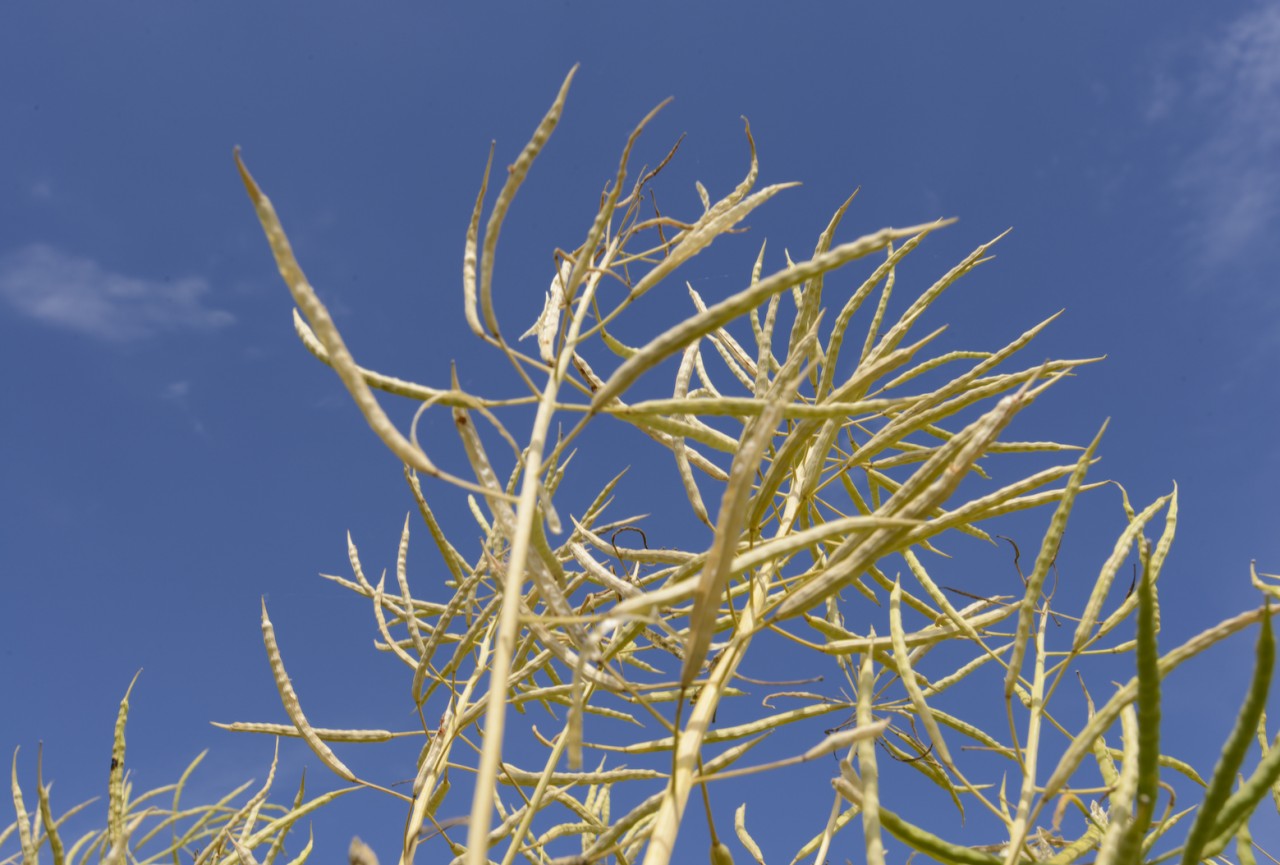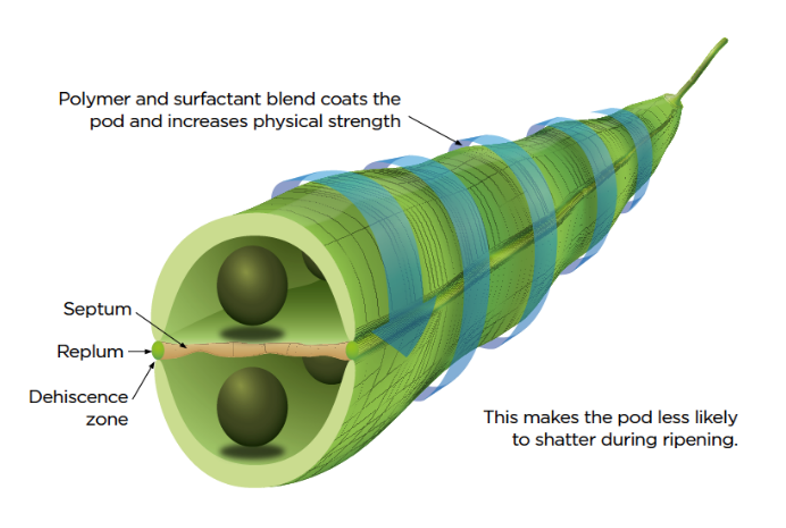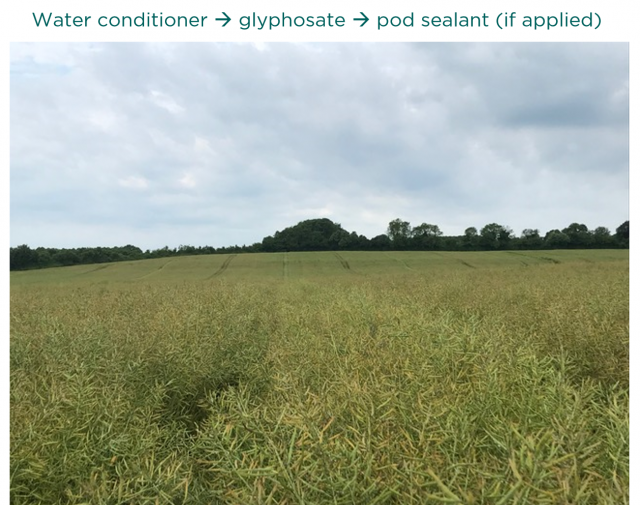Preparing oilseed rape for harvest
Harvest is just around the corner for oilseed rape and there are some final but important tasks required now that the crop has reached this point in its life cycle. Across the country, many oilseed rape crops have been looking well but this means that careful consideration is required when planning desiccation and necessary steps should be taken to safeguard crop potential.
Using pod sealants to aid desiccation
The use of a pod sealant should be considered for all rape crops and within all crop desiccation strategies as they can offer valuable protection in case of poor harvest conditions. They are especially important for variable or inconsistent crops where pre-harvest treatment may be more challenging too.
Trials have shown that the use of pod sealants can increase yield by 0.2t/ha when used with glyphosate. If applied ahead of glyphosate, yields can increase further to 0.4t/ha.
Applying pod sealant
In terms of product choice, a pod sealant such as Senate has several benefits and can therefore be a good option.
Senate can be mixed with your desiccant or applied singularly before desiccation if preferred. Once it has been applied to your oilseed rape crop, the product coats the pods with a thin polymer which essentially holds the pod together to reduce risks of shattering and associated yield losses.
The best time to apply Senate is at the earliest, full size green pod stage – i.e. four to five weeks before desiccation. This has the benefit of less crop damage as the sprayer travels through the crop. Remember: any subsequent applications should always be made in the same direction of travel along the tramlines.
Considering the three main methods of desiccation – which is best?
When it comes to selecting the most appropriate method of desiccation for your oilseed rape, you should make your choice based on the condition and intended end-use of your crop. Opting for the most suitable method will ease the harvesting process, as well as help to maximise yield and the oil content captured.
The three most common methods of desiccation are: direct combining, swathing and chemical desiccation.
1 - Direct combining
If crops are even, standing well and generally weed-free, direct combining can take place following natural senescence. The main benefits of this method include chemical/operational cost savings and not causing crop damage along tramlines with a late-season sprayer pass. This option may be particularly favourable for crops grown for seed.
There are disadvantages to this method, however, these come down to individual circumstances and requirements. Direct combining can be later and slower, which may put pressure on harvest workloads early in the season. Harvest date can be less predictable too and if crops do not ripen evenly, yields and/or oil contents can be compromised.
2 - Swathing
This method requires good straw length for the cut swath to lie on to enable good air flow around the crop. It also requires an even pod depth.
The main benefit of swathing is that your harvest date is much more predictable; oilseed rape is quick to dry-down in swaths compared to other methods.
There are some disadvantages to swathing though. This method requires some specialist, independent machinery which is not always typically accessible on farm. Swathing can also make some crops prone to high seed loss in the event combining has to be delayed. However, the use of a pod sealant such as Senate can provide some level of insurance against this and can be applied to the crop before swathing.
3 - Desiccation with herbicides
This method is the most popular in the UK. Currently, the main active substance available for use is glyphosate but there are some things to consider before application:
- Glyphosate can be used to help finish evenly ripening crops and where perennial weeds require treatment prior to harvest
- It is not a true desiccant. It works by inhibiting amino acid production and effectively starving the plant, rather than damaging cell membranes at the point of contact
- As the process of desiccation with glyphosate can take time, you should plan to harvest 21 days after carrying out the treatment. In the right conditions, some crops may be ready to cut in 14 days which is the minimum harvest internal (HI) for all glyphosate products on oilseed rape
- If it hasn't been applied already, you can add Senate into your glyphosate application to help maintain pod integrity. This is true even where varieties carrying an anti-pod shatter trait are being grown. Senate should be applied in 100-200l/ha water volume, with the lower volume having been shown to save more seed
- In terms of tank mixing order, follow the below for best results:
Take timing into account
Before applying glyphosate, you need to ensure your oilseed rape crop is at the correct phase in the growth cycle. There are some checks you can carry out to ensure this is the case.
In a representative area of the field or block to be treated, pick 20 pods from the middle of the main racemes. The seed should be below 30% moisture content and a colour change from green to brown should be evident in at least two-thirds of the seeds in any pod, and in at least 15 of the pods picked.
You should repeat this assessment in other areas of the field to confirm that the crop is at the correct stage of development for pre-harvest desiccation throughout. If this is the case, the crop is ready and should be sprayed within three to four days.
If you find that only half of the seeds in each pod are turning brown, you should allow another three to four days for the crop to ripen before carrying out the same checks again.
Preparation is key
Whatever your circumstance, the desiccation of your oilseed rape will require careful thought and planning to ensure you get the most from your crop.
We've all seen the devastating effects that a hailstorm can have on oilseed rape and while it's not a guaranteed insurance, taking time to choose an effective pod sealant suited to your crop and specification requirements can be incredibly beneficial.
If you have a plan in place or are unsure of which treatment and desiccation method to choose, make sure you have access to good advice and expertise from a professional agronomist who will be able to offer guidance where necessary.
For help with anything mentioned above, please speak to your local Frontier rep or get in touch.
As a subscriber, you’ll receive email alerts each time a new blog is published so you can always stay updated with the latest advice and insights from our experts








Comments